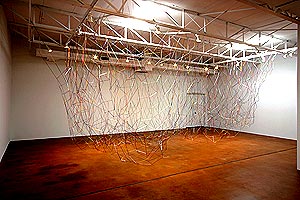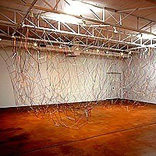There is nothing terribly radical or decadent about saying that meaning and art are odd bedfellows.
This is not to say that contemporary art has no meaning, but rather that the relationship between an art thing and its significance is arbitrary. Their connection and interplay is kinky, promiscuous and open. Case in point is the work of the sculptor and installation artist Margo Sawyer, now showing at Holly Johnson Gallery in the exhibition Margo Sawyer: Cloud of Unknowing.
Critics have consistently read Sawyer’s work according to its “spirituality” and deliberative silence, and for good reason. Sawyer explains that her work emerges from years of “looking and experiencing sacred architecture, taking note of the ancient world and using that spatial knowledge in a contemporary framework.” At the same time, though, her work has other more playful tendencies, and the metaphysical tack decidedly takes the back burner with Sawyer’s installation at Holly Johnson. This work, especially the large Cloud of Unknowing, suggests materialist game rather than sheer transcendent order. Like a lithe playground in denial, Cloud of Unknowing hangs in the back gallery, inviting you inside without ever giving full access. You can see all the way through it; you can even reach your hands inside it. But you can never immerse your entire body in it. Its large, gracefully sagging web of colored tubes creates a container that is porous and transparent: a structure that, though delicate, makes you want to climb. With a palette of metallic and primary colors, this nimble and half-distended blob reads like form on the verge of liquefaction, a melted playground monkeybar that oozes like Dali‘s watches in The Persistence of Memory. Outside of spirituality, her work teases perception, promising so much for the body, but leaving tactile experience to the mind’s eye.
For Sawyer, the dangling reticulation of 10,000 alternating 12” and 15” steel and aluminum bands tumbles through space, “kisses the floor,” as she puts it, and creates “inner space” that you “see but cannot access.” Sawyer achieves her goal of creating solace, and goes beyond. There is a quiet tension in her work that arises from an admixture of the rational and irrational – Sawer’s invention of spaces that can be seen but not entirely felt. It is a subtle friction that results in part from the opposing forces of Mondrian and Pollock, two of her greatest influences. From Mondrian Sawyer takes line, color and the grid; from Pollock the dance-like play of chance and the gesture. In turn, Sawyer curves lines, distorts the grid, pulling it out and squeezing it inward, and rethinks the gesture, leaving her mark according to the accidental fall of interconnected materials in space. In limiting her palette to a few colors and the scale of tubing to two dimensions, Sawyer works according to a system, the singularity of which comes about from the intervention of her tweaking hand. “I am never quite sure how it will look in the gallery,” she explains. Installation is an intuitive process, and as her pieces are bought and are moved from gallery to gallery, they are never the same thing twice. Cloud of Unknowing began as six sheets of tubes drop-hanging in the shapes of diamonds. With the help of an assistant, she pulled and tied the curtains together, creating a supple architecture that brings to mind an animated geodesic dome by Buckminster Fuller. The play of space has become central to Sawyer’s work. Though she is a habitué of creating spaces that playfully invite without actually letting you in (Elysian Fields (1996), Presence and Absence (1998) and Blue (1998) also deploy this trope), a recent landscape-architecture commission is fully inhabitable. Working with the design team of Hargreaves Associates and Page Southerland Page, Sawyer is designing an 11-acre park near Houston’s Convention Center and Hilton Hotel.
While Sawyer has shown well-honed talent in molding three dimensions in space, she does not neglect the tradition of the wall. Veil is a smaller work of networking multi-colored tubes that hangs on the wall and Cologne #2, Canopy and Smoke are powder-coated steel and aluminum rectangular modules that are mounted on the wall. This work, both network and minimalist prefab pieces, are more powerful when placed on the floor or hung in space in the full-round. Mounting them on the wall proves to domesticate them, transforming the tension and desire that comes with installation in full-body space into impotent wall gazing.
Images courtesy Holly Johnson Gallery.
Charissa N. Terranova is an Adjunct Professor in Art History at Southern Methodist University.





